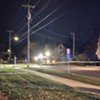Published December 13, 2023 at 10:00 a.m.
'$20 Per Second'
I was horrified to see this statistic that was tucked away in the Gift Guide [November 22]: "State data show that Vermonters spend $20 per second with Amazon."
That's $20 per second!
Imagine how many Vermont residents and businesses would thrive if all that money stayed in Vermont. Imagine how much air pollution would be reduced without all those USPS, UPS and FedEx trucks delivering Amazon packages all day long, not to mention the improvement to the mental health of overworked drivers.
I would love to see this emphasized and maybe even magnified in the main pages of Seven Days. How about a cover story?
Love this paper; keep up your great work!
Cynthia Liepmann
Middlesex
Keep the Puzzle
I feel Paula Routly's pain [From the Publisher: "Puzzle Power," December 6]. Each morning I awake with dread and anxiety for what awaits me.
The New York Times crossword is mine to pursue — kind of like the one-armed man that David Janssen kept running after in the 1960s television show "The Fugitive." Throughout the years, I've learned to live with this challenge: Some days I win; some days I lose.
PS: I enjoy the weekly crossword. You should stick with it.
Barry R. Barton
Irasburg
No More Wind
[Re "Stamford Wind Proposal Tests Whether Large Turbines Have a Future in Vermont," November 22]: If Stamford Wind were a test of whether large wind turbines have a future in Vermont, with the December 7 announcement from Norwich Solar that it is not continuing with the proposal, the answer would be: "No, large wind turbines do not have a future in Vermont."
Annette Smith
Danby
Smith is executive director of Vermonters for a Clean Environment.
'Green' Is Good
How ironic that our little green state has taken such a strong stand against wind power ["Stamford Wind Proposal Tests Whether Large Turbines Have a Future in Vermont," November 22]. On November 26, the BBC reported on a blockade of the world's largest coal port, in Australia. One of the 3,000 protesters, many in kayaks, was 97-year-old Alan Stuart. He said: "I am doing this for my grandchildren and future generations. I am so sorry that they will have to suffer the consequences of our inaction. So, I think it is my duty to do what I can."
As more Vermonters choose electric cars and heat pumps, we will need to get that electricity from somewhere, and wind is a natural resource our state is blessed with!
Those who suggest that wind towers on our ridges will sully tourism values and the view may be confused. Visitors come to Vermont because it is green, and green means much more than just the flora!
The dollars the tourists spend on their Teslas are the same dollars they spend at the EV stations, restaurants and slopes.
We have the opportunity to offer less-guilt tourism to a huge audience who lives within just a few e-vehicle miles from our state!
Doug Goodman
South Burlington
Unacceptable Silence
[Re "Three People Shot Near UVM Campus in Burlington, Police Say," November 25, online]: Burlington spent almost 18 hours without a message from city leadership after the shooting on Saturday, November 25. Even then, after a statement from the mayor's office, citizens spent more than 24 hours wondering if the shooter was still at large.
I'm grateful for everything leaders did behind the scenes to apprehend a suspect and prepare to address this situation as a hate crime. I was also terrified, for my own family, but even more for others: Palestinian neighbors, hijab-wearing friends, others feeling helpless in the long silence.
Why was "shelter in place" called for in Lewiston, Maine, but not in Burlington? In both cases, there was a known shooter unaccounted for. Was a safety calculation made and not communicated? I'm disturbed to think that Burlington's leaders felt this threat was toward Palestinian or visibly Muslim individuals so ... everyone else should continue business as usual?
Where was the early morning press conference saying, "This is serious; we are putting everything we have into this. If you are able, stay off the streets and at home. If you are feeling unsafe, these resources are available to you..."
All politics is local — even, maybe especially, when it feels far away. The Palestinian struggle for safety is not abstract. Islamophobia and the violent targeting of people of color in this city are not abstract.
Burlington prides itself on being a progressive city, but silence on a morning laced with terror is not acceptable leadership. We needed more in those first 18 hours. We need more.
Jen Lazar
Burlington
DCF Is Broken
[Re "The Loss of Grace," October 25]: I was not only heartbroken but outraged and sickened to read the details of what was going on at the Woodside Juvenile Rehabilitation Center and Department for Children and Families' participation in this story.
Sadly, it's a very familiar story to me after working most of my life in human services. I worked for 28 years at the Committee on Temporary Shelter before retiring in 2015. What I heard throughout those years were countless stories from clients who had spent their youths in DCF custody, most in multiple foster care placements.
When a child is removed from their family home, they experience PTSD, so imagine what a child experiences after multiple placements. They start displaying aggressive behaviors, suicidal ideation and hallucinations similar to those of war veterans. As young adults, they have attachment disorders, borderline and antisocial behaviors that lead to homelessness, addictions and criminal behaviors. If one is truly concerned with these issues, well, it begins with caring and protecting the most vulnerable children.
DCF services are broken here in Vermont and across much of the country, and new, innovative models of care must be explored. I know for a fact that DCF caseworkers are committed, compassionate people with big caseloads and, like most human service workers, get little acknowledgement and low wages. There needs to be more federal and state money for mental health and children's protective services. We can't sit back any longer and watch vulnerable children suffer.
Lucia Volino
Shelburne
A Strip
I keep measuring in my mind
a strip of land 25 miles long,
11 miles wide. Here, say in Vermont.
From Middlebury to Burlington.
With our lake, to the west.
Of what used to be the Champlain Sea.
And mountains to the east.
Appearing to be green.
North and south, a town or village.
Of another country. In this
facsimile. In my dream. Boxing me in.
I'm forcing myself, too, to see two million
citizens crammed under one roof
of the sky. And remembering the room
the poet e.e. cummings painted
in his novel "The Enormous Room."
I'm hoping to read someday.
I've read it speaks to his and his friend
Bill's arrest
for anti-war sentiments.
For e.e., an ambulance driver, sticking up
for him. In the history of World War I.
And then in his poetry.
Without borders.
Which I find difficult and fun.
Seeing his words make the most
of a page's empty spaces. Breaking
a grammarian's rules. For the sake
of peace and the imagination.
And e.e.'s wife, who, it's reported,
asked her husband, walking upstairs
from his study in their basement
in Cambridge, after a full morning's
>writing, whether or not he was havinga good day.
To which he apparently said,
with a straight face, I changed
a period to a comma. Which for all
intents and purposes might be what
the world needs to save itself
from itself. For me to offer my extra
room to a stranger. To begin walking
from here to Burlington. And then
over to the lake. And back to
the mountains. To feel as much
as I can for them and not in my mind.
Which doesn't stand for a strip
of my heart.
Gary Margolis
Cornwall
New View of November
I'd like to thank you for writing the profile of photographer Paul Rogers ["The Novemberist," November 22]. As an amateur photographer, I am always looking for inspiration to get outside with my camera and take pictures. November, suffice it to say, is not a month I look forward to for creative inspiration. Rogers' beautiful photography represented in his "Stick Season" online gallery was just the nudge I needed to look at our beautiful home state in a new way and, quite literally, in a new light.
Robert Coleburn
Ferrisburgh
'Incendian Problem'
[Re "Chord and Discord: Odanak Musician Mali Obomsawin Talks Music, Community and Vermont's 'Pretendian Problem,'" September 27]: Vermont does not have a "pretendian problem" — it has an "incendian problem." By highlighting the incendiary opinions of a few outspoken individuals — who have no legal authority whatsoever to adjudicate anyone's Indigenous identity — journalists are contributing to a firestorm of slander, provoking troubling conversations among Native people and the general public.
As a simple point of fact, no individual holds the inherent right to determine who is or is not legally "Indian" in the United States or Canada. Nothing in any federal, provincial or state law, and nothing in any traditional Indigenous practice of governance, gives any Native American or First Nations person or tribe the legal right to judge the identity of any other Native American or First Nations person or tribe. Such determinations can only be made by and within a sovereign tribal nation, over its own citizens.
Under Vermont Statute Title One, Chapter 23, the Abenaki nations in Vermont are legally recognized and identified as "Native American Indian People." Under the United States Indian Arts and Crafts Act of 1990, they are legally recognized as Native American artists, "defined as a member of any federally or officially State recognized tribe of the United States."
Although many Abenaki people are being slandered as a direct result of this biased reporting, they have nonetheless received personal reassurances from many respected citizens of American and Canadian tribal nations who are appalled by the recent media coverage that is causing an enormous amount of unnecessary chaos and confusion.
Margaret Bruchac
Northampton, MA
Down Wind
Nice try, but no Pulitzer Prize for ["Stamford Wind Proposal Tests Whether Large Turbines Have a Future in Vermont," November 22]. Kevin McCallum drank the windmill Kool-Aid from Martha Staskus, all right. Residents of Stamford get various used-car stories from her and Norwich Solar since she ginned up this idea on environmentally challenged land, already hit by past Act 250 violations. The all-green-is-wonderful spiel is enough to turn one into an Exxon-breathing Republican.
As I am an adjacent landowner to this five-story monster, this will be in my face. With 45 in the area, why not one more windmill? The same old real estate developer model Staskus has used, so she can cash out and flip this to out-of-state investors, doesn't cut it with the people in Stamford, who will be forced to see and listen to her "work" for the next 25 years. If so wonderful, how about some windmills offshore in Lake Champlain? There is wind there, too.
What is good enough for Stamford is good enough for Burlington. Or are we just a colony to be looted like some poor town in Louisiana for another petrochemical complex? Go talk to some of the nearby landowners in Staskus' other past windmill projects and see their reactions. That's if they didn't sign nondisclosure agreements.
Stop the PR pieces for wind and solar as the only way to save the planet. All energy has a cost, green energy included. There are environmental, material, recycling and economic costs not outlined in this piece. Green energy is not a no-cost magic bullet. Stop dividing Vermont into a green-power-or-death class war; it is a broad and complex issue. The green ideological fanatics are becoming as destructive as the old-school fossil fuel ideological fanatics.
Richard Silc
Stamford
Wind in Chittenden County
I would love to see us shift the conversation on wind power in Vermont by building a community-owned project in Chittenden County ["Stamford Wind Proposal Tests Whether Large Turbines Have a Future in Vermont," November 22].
When people are literally bought into wind power, they become strong supporters. Putting a big project where people live and where the electric demand is would help address concerns about rural areas shouldering more than their share.
Wind power in the Champlain Valley wasn't viable years ago, but newer, larger turbines are better at capturing energy from lower wind speeds.
Let's build a popular wind project in the valley, demonstrating distributed ownership as a better way to do it!
Damon Lane
Burlington
Beats Fossil Fuel
As I read comments by Annette Smith and Lisa Gramlin opposing a proposed wind project in Stamford ["Stamford Wind Proposal Tests Whether Large Turbines Have a Future in Vermont," November 22], one question jumped to my mind: What about the impact of the power plants that we can't see from Vermont?
Across the contiguous United States, more than 32 million people live within three miles of a fossil fuel power plant. According to the U.S. Environmental Protection Agency, nitrogen oxide emissions from these plants "contribute to the formation of ground-level ozone and fine particle pollution, which cause a variety of adverse health effects, including decreased lung function, aggravated asthma, and premature death."
The closest fossil fuel plants to Stamford — again according to the EPA — is a quartet of natural gas plants in Albany, N.Y. Albany has a population of close to 100,000 people and is a community with environmental justice concerns due to the high share of residents who are low income and/or people of color. The next closest is Springfield, Mass., population 150,000, also disproportionately low income and non-white.
Sadly, saying no to renewables in Vermont means more reliance on gas plants in communities like these. We might not be able to see the smokestacks from Vermont, but they are there and far more harmful to the environment, human health and community well-being than any wind turbine could ever be.
Jonathan Dowds
Burlington
Dowds is deputy director at Renewable Energy Vermont
What's Wrong With Wind
A pitchfork-wielding, angry mob of locals as the front piece to your article tips the author's hand ["Stamford Wind Proposal Tests Whether Large Turbines Have a Future in Vermont," November 22]. The green energy conversation won't be moved forward by biased pieces such as this.
Suggesting that the powerful turbine would be nearly imperceptible with its blades barely peeking over a distant stand of trees and yet be the tallest structure of any kind in the state is illogical. These cannot be true at the same time.
This article downplays the vital importance of Stamford's enhanced energy plan. Town officials are not suddenly "decrying"; they in fact made it specific policy for the town in 2019 stating industrial turbines must be one kilometer from residences.
Informed discussion? A public hearing was held, at which Norwich Solar gave vague answers or expressed outright ignorance when faced with questions from residents. When asked directly about potential health risks, Norwich claimed not to understand what the question meant.
The turbine would not be remote; it would be half a mile from homes. Choosing a site almost literally on top of the only residential development in a town that is predominantly wilderness is a hostile act, taking advantage of a small town without the resources to hire legal representation.
If developers used their collective heads, wind wouldn't be in a coma. Don't site these behemoths on top of people's homes, and wind projects won't experience the failures that have plagued them since 2017.
Tammy Elias
Stamford
Sounds Like a Bad Idea
Kevin McCallum's article on the proposed wind project in Stamford largely ignores setbacks in reducing noise impacts from industrial wind ["Stamford Wind Proposal Tests Whether Large Turbines Have a Future in Vermont," November 22].
According to sound experts, noise problems can be mitigated by insulating either the noise emitter or the receptor: With wind turbines and their neighbors, neither is possible. The only solution is to keep the turbines far enough away from homes so that noise problems (for humans, anyway) are minimized.
In 2017, the three-member Public Utility Commission — all appointed by pro-wind governor Peter Shumlin — established setbacks of at least 10 times a turbine's height from the nearest home. The Stamford project's 500-foot turbine would have approximately 80 homes with that setback.
Unfortunately, pressure from the legislature led to the elimination of the PUC's commonsense rule — and to raising the nighttime noise limit from 35 decibels to 39 decibels.
McCallum repeats the misleading trope that 39 decibels "is about the sound of a quiet library" — a sound so quiet that it couldn't possibly disturb someone's sleep. But what makes sound a nuisance is how much louder it is than the ambient sound level: The sound of a library wouldn't be bothersome in an apartment on a busy street, but in a rural setting — where ambient noise levels are as low as 17 decibels — an outside noise of 39 decibels can easily prevent a good night's sleep.
Audible and infrasound problems from Vermont's existing wind developments have already driven neighbors from their homes. Setbacks are the only regulatory solution to this problem.
Suzanna Jones
Walden
Don't Forget Gas
[Re "Stamford Wind Proposal Tests Whether Large Turbines Have a Future in Vermont," November 22]: Robert Bryce, an author on energy policy, notes that earlier this winter, the Federal Energy Regulatory Commission and the North American Electric Reliability Corporation issued their final report on a winter storm that hammered the northeastern U.S. last year. It shows that our "just-in-time" natural gas grid is just as essential as our electric grid. FERC and NERC have repeatedly said the two grids are intertwined, interdependent and irreplaceable. A reliable and resilient natural gas grid is critical to our energy and national security.
The report, "Inquiry Into Bulk-Power System Operations During December 2022 Winter Storm Elliott," explains how the gas pipeline network in New York nearly failed last Christmas when temperatures plummeted during the bomb cyclone. Freeze-related production declines, combined with soaring demand from power plants, homes and businesses, led to shortages of gas throughout the Northeast. The lack of gas, as well as mechanical and electrical issues, resulted in an "unprecedented" loss of electric generation capacity. While the lack of electricity was dangerous, the possibility of a loss of pressure in the natural gas network should send shivers through the Northeast.
The report explains that if the gas pipeline system had failed, the recovery process in New York City would have taken "months" because each pilot light needs to be individually relit by utility crews. The cold from December 23 to 28 could have resulted in tens of thousands of deaths.
Please take heed?
Bill Miller
South Burlington
More By This Author
Comments
Comments are closed.
From 2014-2020, Seven Days allowed readers to comment on all stories posted on our website. While we've appreciated the suggestions and insights, right now Seven Days is prioritizing our core mission — producing high-quality, responsible local journalism — over moderating online debates between readers.
To criticize, correct or praise our reporting, please send us a letter to the editor or send us a tip. We’ll check it out and report the results.
Online comments may return when we have better tech tools for managing them. Thanks for reading.















































